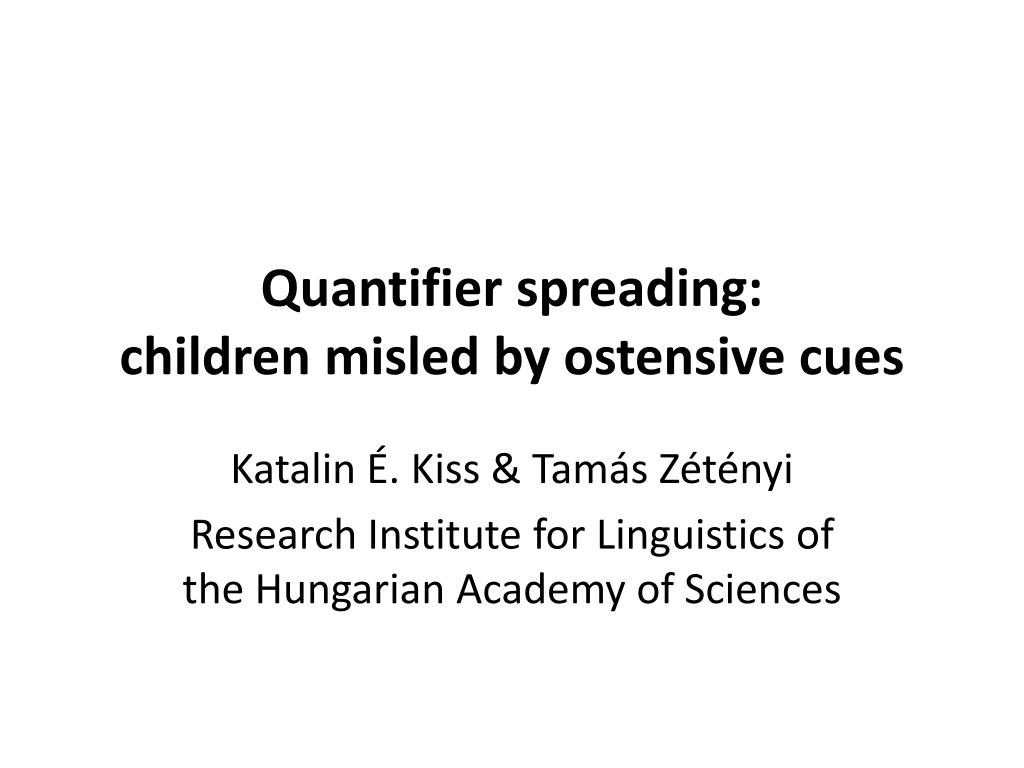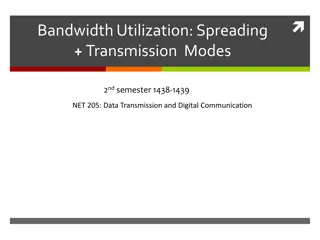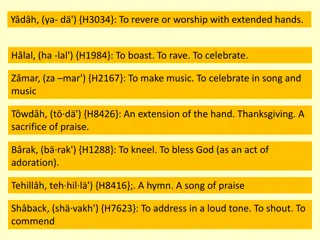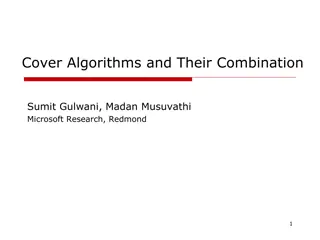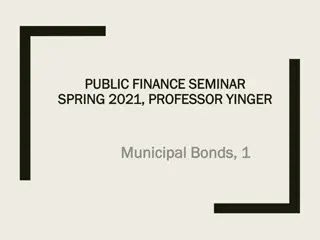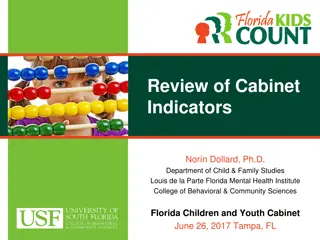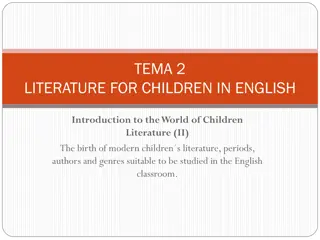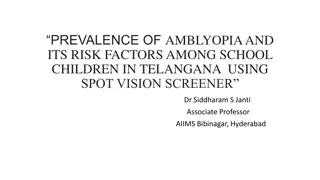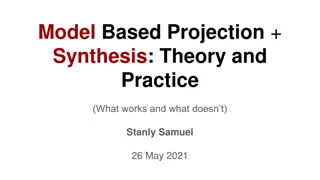Understanding Quantifier Spreading in Children
Researchers at Katalin Kiss & Tam.s Z.tnyi Research Institute for Linguistics of the Hungarian Academy of Sciences explore the phenomenon of quantifier spreading in children, where they are misled by ostensive cues. The study discusses classic spreading, underexhaustive search, theories of quantifier spreading, linguistic explanations, and a parsing problem repaired by pragmatic processes. Counter-evidence and cognitive explanations add depth to the understanding of this linguistic phenomenon.
Download Presentation

Please find below an Image/Link to download the presentation.
The content on the website is provided AS IS for your information and personal use only. It may not be sold, licensed, or shared on other websites without obtaining consent from the author. Download presentation by click this link. If you encounter any issues during the download, it is possible that the publisher has removed the file from their server.
E N D
Presentation Transcript
Quantifier spreading: children misled by ostensive cues Katalin . Kiss & Tam s Z t nyi Research Institute for Linguistics of the Hungarian Academy of Sciences
The phenomenon: 1. Classic spreading Is every girl riding a bicycle? No, not that one.
2. Bunny spreading Is every bunny eating a carrot? No, not that one.
Underexhaustive search is a different phenomenon: Is every girl riding a donkey? Yes. Cause: failure to pay attention; affirmative response strategy
Theories of Quantifier Spreading Cognitive explanation Inhelder & Piaget (1958, 1964): immature cognitive (logical) abilities, problems with categorization
Linguistic explanations: problem with the domain of quantification Philip (1995): QS is quantification over (sub)events Is every girl riding a bicycle? = Is every subevent an event of a girl riding a bicycle? Counter-evidence: spreading in non-eventive sentences: Is every girl a bicycle rider? No, not that one.
A parsing problem repaired by pragmatic processes: Drozd&Loosbroek 1999, Drozd 2001, Geurts 2003: Children treat universals as if they were weak quantifiers with no fixed domain. They supply the domain of quantification pragmatically. Replacing (b) with (c): a. Every boy is riding an elephant. b. [ x: boy(x)] <every> [y: elephant(y), x rides y] c. [ ... : ... ] <every> [x, y: boy(x), elephant(y), x rides y]
Counter-evidence: QS also occurs with weak (numerical) quantifiers We found that 4 out of 32 children (12,5%) show systematic QS with numerical quantifiers. E.g. Picture showing 3 girls riding bicycles, and an extra bicycle: Three girls are riding a bicycle. No, four.
Philip (2011): Relevance Account Universal quantification triggers exhaustive enumeration verification, which activates symmetrical pattern recognition. The missing object spoiling symmetry is salient for the child, who imagines it to be existent. (1) Salient Object Strategy If an object is contextually relevant, then it is salient. (2) A missing agent that spoils a symmetrical pattern is salient.
The frequency of QS can be changed by manipulating the pragmatic conditions: Richer linguistic context (Crain et al. 1996: condition of plausible dissent) or richer visual context (Freeman et al. 1982: more than one extra object, etc.) or a backgrounded extra object may reduce QS.
Hypothesis: Children give non-adult-like answers because they consider all the elements in the visual stimulus relevant. They assume that the icons represented in the pictures are all to be accounted for; their totality constitutes the domain of quantification.
Children are misled by theirdisposition to show preferential attention to ostensive signals. Csibra & Gergely (2009), Gergely & Jacob (2012), Butler & Markman (2014), etc.: Children encode the content of ostensive communication as representing relevant episodic information or generalizable knowledge.
Butler & Markman (2014): Preschoolers give more credit to ostensive demonstration than to salient perceptual clues Three groups of preschoolers observed identical evidence presented accidentally, intentionally, and communicatively that a novel object had a certain property (magnetism). They identified magnetism as an inherent property of the object only when it was demonstrated communicatively.
Claim: When the visual stimulus in a sentence-picture matching task is a minimal model abstracting away from the details of the situation, children regard the elements of the stimulus as ostensive clues. They assume that these ostensive clues represent and only the relevant elements to be matched with the sentence.
Experimental evidence Objectives: To show that if the visual stimuli consisting of a few icon-like elements are replaced by photos rich in accidental details, they are not misunderstood as ostensive signals, and QS is radically reduced.
Participants: XX children from 3 Budapest kindergartens, Mean age XX, SD XX Method: Sentence-picture matching; truth value judgement
Materials: 8 test sentences (+ 16 fillers), associated with an iconic drawing and a photo Procedure: Children divided into 2 groups. Group A judged sentences 1-4 associated with a drawing, and sentences 5-8 associated with a photo. Group B judged sentences 1-4 associated with a photo, and sentences 5-8 associated with a drawing.
Discussion: QS is a consequence of misleading experimental methodology. If the visual stimulus associated with a quantified sentence is a minimal model devoid of redundant details, the child tends to interpret all of its elements as ostensive clues figuring in the meaning of the sentence. If the ostensive effect is diminished by the use of photos taken in natural environments, the proportion of QS is reduced by more than 50%.
Misleading ostensive effects in other types of language acquisition experiments Testing scalar implicatures: In a game, the child has pulled 4 identical cards. Experimenter: Those who have 3 identical cards get a balloon. 100% of children: Sorry, I don t have three. The child assumes that the numeral in the experimenter s utterance must be interpreted on the domain constituted by all the elements on the stimulus card.
In a natural situation: During a game, there are 4 glasses on the table. Experimenter: Please, pour us some water. Are there 3 glasses on the table? 85% of children: Yes, there are.
Conclusion: In experiments testing children s sentence interpretation, the stimuli are often misinterpreted as ostensive cues, as a consequence of which they elicit reactions that do not occur in natural circumstances. The cause of misinterpretation can be the iconicity of the stimulus, or the test situation itself.
References: Butler, L.P. & E.M. Markman 2014. Preschoolers use pedagogical cues to guide radical reorganization of category knowledge. Cognition 130. Csibra, G., Gy. Gergely 2009. Natural Pedagogy. Trends in Cognitive Sciences 13, 148-153. Drozd, K.F. 2001. Children s weak interpretations of universally quantified sentences. In Conceptual Development and Language Acquisition, ed. M. Bowerman and S.C. Levinson, 340-376. CUP. Geurts, B. 2003. Quantifying kids. Language Acquisition 11: 197-218. Gergely, Gy., P. Jacob 2012. Reasoning about instrumental and communicative agency in human infancy. In Rational Constructivism in Cognitive Development, ed. T. Kushnir, 59 94. Academic Press. Philip, W. 1995. Event quantification in the acquisition of universal quantification. PhD diss., Umass, Amherst. Philip, W. 2011. Acquiring knowledge of universal quantification. In Handbook of Generative Approaches to Language Acquisition, ed. J. de Villiers, T. Roeper, 351-394. Dordrecht: Springer.
